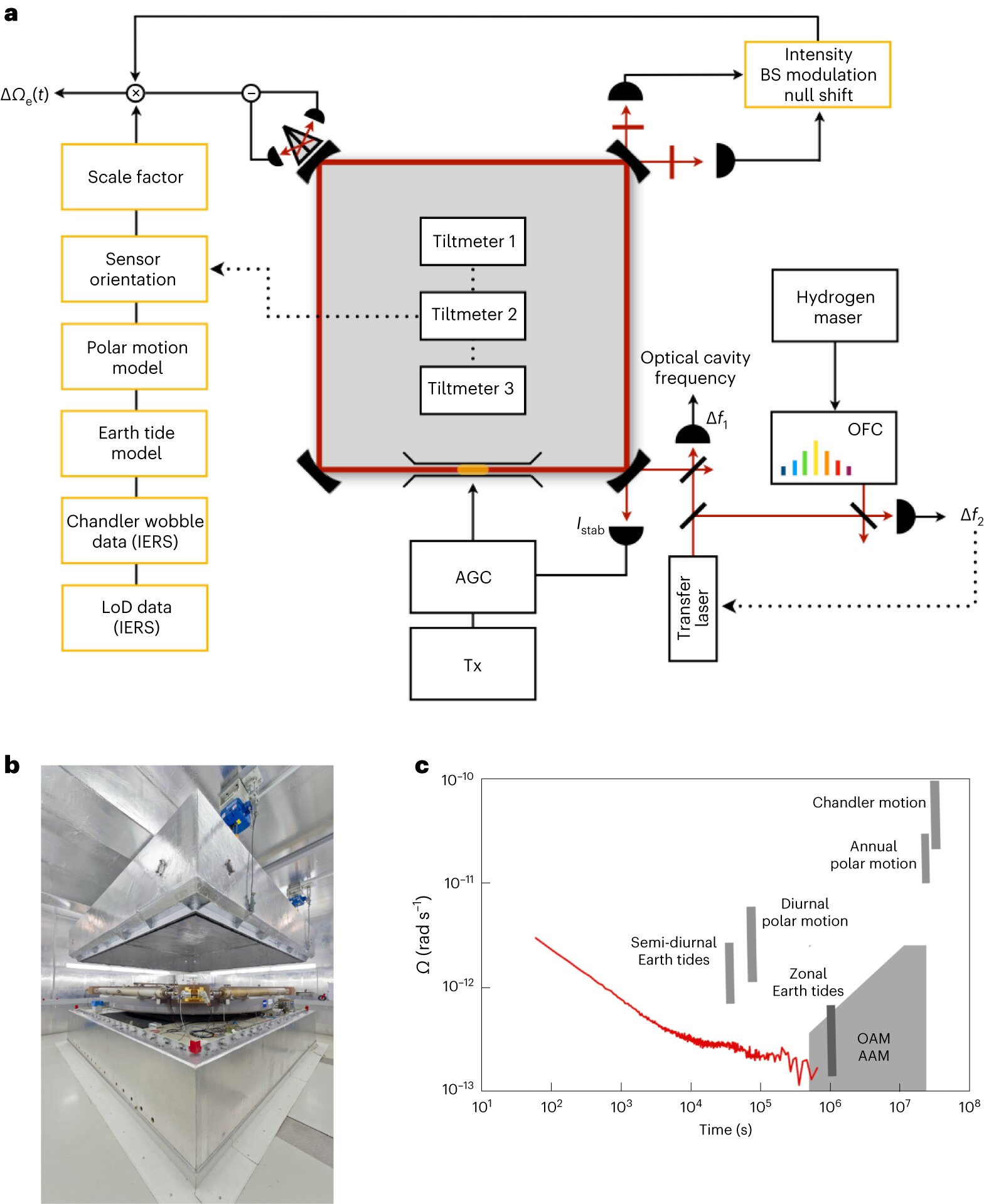Welcome to DU!
The truly grassroots left-of-center political community where regular people, not algorithms, drive the discussions and set the standards.
Join the community:
Create a free account
Support DU (and get rid of ads!):
Become a Star Member
Latest Breaking News
Editorials & Other Articles
General Discussion
The DU Lounge
All Forums
Issue Forums
Culture Forums
Alliance Forums
Region Forums
Support Forums
Help & Search
Science
Related: About this forumUsing a gyroscope to measure variations in Earth's rotation
From phys.org

Instrumental design and observed sensitivity of the ring laser gyroscope G. a, The 4 × 4 m2 high-quality-factor ring laser cavity and the experimental layout is illustrated in a simplified block diagram. Four super mirrors rigidly fixed to a temperature-stable Zerodur base provide the necessary sensor stability. b, Photograph with the pressure-stabilizing vessel lifted up. c, Long-term ring laser resolution is presented in an Allan deviation plot with respect to the approximate magnitude and frequency range of known geophysical excitations. The yellow boxes indicate the numerical processes, whereas the black boxes mark the instrumentation. OFC, optical frequency comb; AGC, automatic gain control; Tx, transmitter; OAM, ocean angular momentum; AAM, atmospheric angular momentum. Credit: Nature Photonics (2023). DOI: 10.1038/s41566-023-01286-x
_________________________________________________________________________________________________
...
For many years, scientists have been attempting to improve on measures of the precision of the Earth's rotation—to more clearly describe the length of a given day. Making things more difficult is that the length of a given day depends on many factors, such as the pull of the moon, ocean currents and which way the wind blows. Prior efforts to measure the length of a day has involved use of radio telescopes or signals sent by many facilities stationed on Earth. In more recent times, Earth-orbiting satellites have been used, increasing precision. In this new effort, the researchers have tried a new approach—using a gyroscope.
The gyroscope, which has been named simply "G," is based at Germany's Geodetic Observatory Wettzell. It was made using a 16-meter-long laser cavity, making it a ring type. Inside, dual laser beams traveling in opposite directions of one another interact, which results in the creation of an interference pattern. The system works because the laser that moves in the same direction as Earth is more stretched than the one that moves in reverse.
Then, as Earth rotates, fluctuations in its rate of speed are reflected in fluctuations in the interference pattern. From that, the researchers were able to calculate how much distance a given point on Earth had traveled over a given time period. Repeating the exercise over multiple days gave them the ability to factor in variations over time, and that allowed them to measure the length of a given day to within just a few milliseconds over a four-month period.
The researchers conclude by suggesting that their method for measuring day-length, as well as their variations—because it is far more precise than any other method—could be used to build better geophysical models, which could be used for global transport.
The paper in Nature Photonics is behind a paywall, but the abstract is available and provides some additional information, including that they are measuring the sidereal day and that the gyroscope is in the Sagnac configuration.
Abstract
An exact knowledge of the instantaneous Earth’s rotation rate is indispensable for accurate navigation and geolocation. Fluctuations in the length of sidereal day are caused by momentum exchange between the fluids of the Earth (namely, the atmosphere, hydrosphere and cryosphere) and the solid Earth. Since a multitude of different globally distributed and independent mass transport phenomena are involved, the resultant effect on the Earth’s rotation is not predictable and needs to be continuously measured. Here we report the observation of minute variations in the rotation rate of the Earth at the level of five parts per billion, namely, with a resolution of a few milliseconds over 120 days of continuous measurements. We employ an inertial self-contained measurement technique based on an optical ring laser interferometer rigidly strapped down to the Earth’s crust and operated in the Sagnac configuration. This large-scale gyroscope integrates over three hours for each data point, as opposed to an entire global network of Global Navigation Satellite Systems receivers and Very Long Baseline Interferometry that can only provide a single measurement per day.
InfoView thread info, including edit history
TrashPut this thread in your Trash Can (My DU » Trash Can)
BookmarkAdd this thread to your Bookmarks (My DU » Bookmarks)
3 replies, 922 views
ShareGet links to this post and/or share on social media
AlertAlert this post for a rule violation
PowersThere are no powers you can use on this post
EditCannot edit other people's posts
ReplyReply to this post
EditCannot edit other people's posts
Rec (6)
ReplyReply to this post
3 replies
 = new reply since forum marked as read
Highlight:
NoneDon't highlight anything
5 newestHighlight 5 most recent replies
= new reply since forum marked as read
Highlight:
NoneDon't highlight anything
5 newestHighlight 5 most recent replies
Using a gyroscope to measure variations in Earth's rotation (Original Post)
Jim__
Sep 2023
OP
EYESORE 9001
(27,504 posts)1. wut
I went into a trance trying to read the first paragraph. Just kidding. This will revolutionize submarine navigation while underwater, along with a host of applications I haven’t even thought of.
Climate Crusader
(91 posts)2. Well, duh.
Mr. Obvious.
AZ8theist
(6,486 posts)3. How can this POSSIBLY WORK when the Earth is flat????
